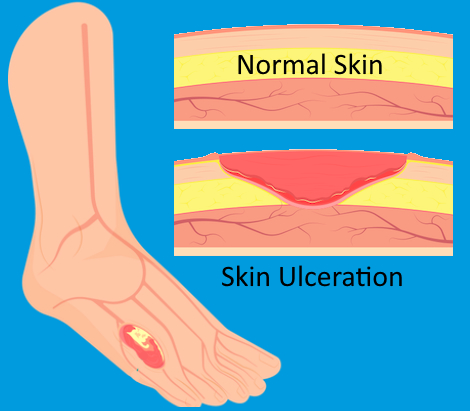Ischemic Ulcers
ISCHEMIC ULCERS Q & A
What Are Ischemic Ulcers?
Ischemic means reduced blood flow to a part of the body. Ischemic ulcers are slow healing wounds. Usually found on the feet, ankles, or legs, they develop due to limited blood supply through the arteries to the legs. Ischemic ulcers are also known as arterial ulcers.
What Causes Ischemic Ulcers?
Ischemic ulcers are caused by limited blood flow from the arteries to the legs. Reduced circulation may be due to diabetes, inflammation, fat blockages, clogged arteries, peripheral arterial disease (PAD), or infection. When blood does not reach the extremities, the area fails to get adequate oxygen and nutrients. This causes tissue damage and even cell death. The damaged, blood deprived tissue is unable to heal. If untreated, ischemic ulcers can lead to gangrene and limb loss. Like diabetic ulcers, the patient may have nerve damage that makes it harder to feel when a wound occurs and needs attention.

Frequently Asked Questions
Ischemic Ulcers Patient Education
What Are Symptoms of Ischemic Ulcers and Peripheral Arterial Disease (PAD)?
Symptoms of ischemic ulcers include:
- Pain, often at night. May be reduced when leg is dangled
- A “punched out” appearance. The ulcer’s borders look regular and well-defined.
- Skin looks pale or possibly red. It may also appear shiny and with less hair.
- Skin feels cool to the touch
- Drainage from ulcer or blisters
- Fever and chills
- Swelling may be present
- Signs of gangrene and/or infection
- Little or no bleeding from area
- Visible wound on feet, ankles, legs or between toes
Symptoms of PAD include:
- Wounds and sores that will not heal
- Pain when legs are at rest
- Toes, feet, and legs appear blue
- Leg hair and toenails do not grow
Can Ischemic Ulcers Be Prevented?
Managing health conditions, regular doctor visits, and living a healthy lifestyle with a balanced diet and exercise can help reduce the risk of ischemic ulcers. Protect feet from cold and wear appropriate footwear. Plus, check feet and legs every day. Look for abnormalities, redness, bruising, blisters, cuts, etc. Examine the entire foot and lower leg, including between the toes. Seek medical attention at the very first signs of a sore or wound. Early treatment will bring the greatest chances for healing.
What Are Risk Factors for Ischemic Ulcers?
Risk factors include:
- Smoking
- Diabetes
- Age
- Peripheral arterial disease (PAD) or other vascular disease
- Family history of vascular disease
- Obesity
- Sedentary lifestyle
- High blood pressure
- Arteriosclerosis and/or atherosclerosis
- Trauma
- Renal failure
Do Ischemic Ulcers Need Treatment?
Yes. Ischemic ulcers can eventually lead to gangrene and limb loss if left untreated. With both ulcers and accompanying vascular disease, early treatment to improve blood flow, attack any infection, and promote healing will help prevent further damage and the need to amputate. Minimally invasive treatments are available for patients with ischemic ulcers, PAD, and other vascular diseases.
How Are Ischemic Ulcers and PAD Treated?
Treatment for ischemic ulcers will likely involve many professionals, such as your primary doctor, wound and foot care specialists, and a vascular interventional radiologist. The ulcer will need to be monitored and treated by knowledgeable medical personnel. Treatment may include the removal of damaged tissue (debridement), medication and proper dressing. Plus, a vascular specialist trained in interventional radiology should be consulted to address the arterial issue. This specialist will recommend the best treatment to restore blood flow and improve circulation. These may include angioplasty, atherectomy and stenting.
At AVI, we use the most up-to-date advanced procedures to diagnose and treat ischemic ulcers and PAD. We are dedicated to providing safe and optimal care to all patients.

631 West Avenue Q, Suite A
Palmdale, CA 93551
Phone 661-480-5956
Fax 661-480-5976
Hours
- Monday–Friday
8 am – 5pm
Resources
Connect
